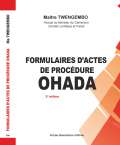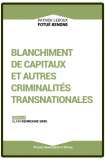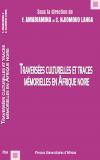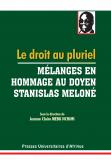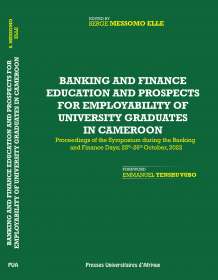
BANKING AND FINANCE EDUCATION AND PROSPECTS FOR EMPLOYABILITY OF UNIVERSITY GRADUATES IN CAMEROON
PROCEEDINGS OF THE SYMPOSIUM DURING THE BANKING AND FINANCE DAYS, 25th-26th OCTOBER,2022
Banking and finance, although a very old intellectual concern dating to the early days of the modern economy, constitute relatively recent and late components of the university training in Cameroon.
| Détails sur le livre | |
|---|---|
| Auteur | Edited by SERGE MESSOMO ELLE |
| ISBN | 978-9956-532-43-8 |
| Nombre de pages de la version papier | 418 pages |
| Format | 165/240 mm |
| Date de publication | 2025 |
| Editeur | Presses universitaires d'Afrique |
| Langue | Anglais |
Banking and finance, although a very old intellectual concern dating to the early days of the modern economy, constitute relatively recent and late components of the university training in Cameroon. Although an essential dimension of commercial or technical-commercial education at secondary school education in the parallel English and French sub-sectors, they only had a timid echo in the higher education system, either couched in economics programmes or as a part of specialised training in the lone Higher Technical Teacher Training College going by the French title of Ecole Normale Supérieure d’Enseignement Technique (ENSET), Douala, as a way of ensuring a reproduction of lower level technical -commercial secondary education. This trend seems to still hold part in the official division between general education, on the one hand, and technical-commercial education, on the other. Since the introduction of reforms that ushered in private higher education, which seem to be a near exclusive preserve of the latter, university level education in this domain continues to follow this old dichotomous pattern.
Summary ........................................................................................................................................................................................................................... iv
Forward ................................................................................................................................................................................................................................. vii
PART I: BANKING AND FINANCE EDUCATION .......................................................................... ix
Keynote Address: What does Banking and Finance Entail in Practice? ................... 11
Rose Bonny Wonja
1. Some Historical Background about Banks ....................................................................................................... 11
2. The Cameroon’s banking Sector and Its Evolution ................................................................................ 12
3. About UBA and its Values ..................................................................................................................................................... 12
3.1. About UBA ........................................................................................................................................................................................ 12
3.2. What is behind this Success of UBA? A man, a Vision and Values .................. 13
Understanding of Banking and Finance Knowledge ............................................................................. 15
Serge Messomo Elle & Yao Messah Kounetsron
1. Introduction ............................................................................................................................................................................................... 15
2. Banking and Finance Thoughts ........................................................................................................................................ 16
3. Banking and Finance Techniques ................................................................................................................................... 17
3.1 Techniques Inherent to Banking and Finance ................................................................................... 18
3.2 Techniques Borrowed .............................................................................................................................................................. 19
4. Epistemology of Banking and Finance .................................................................................................................. 19
5. The Banking and Finance Practice ............................................................................................................................ 20
6. Conclusion ...................................................................................................................................................................................................... 22
References ............................................................................................................................................................................................................. 22
Effectiveness of Banking and Finance Education for Job Opportunities in Cameroon: The Case of Banking and Finance Department Curricula of
the University of Buea ............................................................................................................................................................................ 23
Serge Messomo Elle
1. Introduction .................................................................................................................................................................................................. 23
2. Statement of Problem and Research Questions ......................................................................................... 24
3. Research Objectives ............................................................................................................................................................................ 25
4. Literature Review ................................................................................................................................................................................ 25
4.1. Effectiveness of Banking and Finance Education: Some Understanding ....... 25
4.2. Banking and Finance Sector Education Effectiveness and Job
Market Opportunities .................................................................................................................................................................... 27
5. Methodology ............................................................................................................................................................................................... 27
5.1. Research Design and Variables considered .......................................................................................... 27
5.2. Variables and their Measurements ................................................................................................................. 28
5.3. Method and Instruments of Data Collection ................................................................................. 29
5.4. Method and Instruments of Data Analysis ......................................................................................... 30
6. Presentation and Discussion of Results ................................................................................................................. 30
6.1. Results ........................................................................................................................................................................................................ 30
6.1.1. Matching of Banking and Finance Curricula to the components of effectiveness in banking and finance education .................................................................................... 30
6.1.2. Banking and Finance Programmes and Employability of students .......... 32
6.2. Discussion of Results .......................................................................................................................................................... 35
7. Conclusion and Managerial Implications ....................................................................................................... 36
References ......................................................................................................................................................................................................................... 37
Centrality of the Banking System and Construction of Urban Space in Buea and Limbe in South-West Region of Cameroon ........................................................................................ 39
Guy Marcel Ediamam Epalle
1. Introduction .................................................................................................................................................................................................. 39
2. Methodology ................................................................................................................................................................................................ 42
2.1. Location of the Study Area .......................................................................................................................................... 42
2.2. Definition and Operationalisation of variables .......................................................................... 43
2.2.1. Centrality .................................................................................................................................................................................. 43
2.2. Construction of urban space ................................................................................................................................. 44
2.3. Methods and Instruments of data Collection and Analyses .................................... 44
2.4 Limits of the study ................................................................................................................................................................... 44
3. Results and Discussion ................................................................................................................................................................... 45
3.1. Presentation of Results ....................................................................................................................................................... 45
3.1.1. Centrality of banks and accessibility to users ................................................................ 45
3.1.2. The centrality of banking activity redefining the role of the
city at regional level ....................................................................................................................................................................... 46
3.1.3. The socio-economic impacts of the banking Sector ................................................. 48
3.1.4. Centrality of banks and economic performances of urban areas ......... 48
3.1.5 Banks and multiple function of space ........................................................................................... 50
3.1.6 Centrality Evolvement .......................................................................................................................................... 51
3.2 Discussion .............................................................................................................................................................................................. 51
4. Conclusion ...................................................................................................................................................................................................... 53
References .............................................................................................................................................................................................................. 54
Current Competences and Job Opportunities in the Banking Sector: Evidence from Cameroonian Commercial Banks ................................................................................... 59
Giscard Moutie & Serge Messomo Elle
1. Introduction ................................................................................................................................................................................................ 59
2. Theoritical Literature ....................................................................................................................................................................... 60
2.1. Competences portrayed by Soft and Hard Models of HRM and their relevance in Banking Sector ................................................................................................................................................... 60
2.2. Knowledge and Management Theory ...................................................................................................... 63
3. Empirical Literature .......................................................................................................................................................................... 65
3.1 Key Competences and Job Opportunities in the Banking Sector ...................... 65
3.2. Incorporation of KM in Bank Human Resource Management Models ..... 66
4. Methodology .............................................................................................................................................................................................. 68
4.1. Variables Specificities ......................................................................................................................................................... 68
4.2. Method and Instruments of Data Collection and Analyses ................................... 68
5. Results and Interpretations ...................................................................................................................................................... 68
5.1. Presentation of Results ...................................................................................................................................................... 68
5.2. Frequency Table ..................................................................................................................................................................... 69
5.3. Discussion .......................................................................................................................................................................................... 74
6. Conclusion and Managerial Implications ..................................................................................................... 76
References .............................................................................................................................................................................................................. 76
Assessing the Determinants of Entrepreneurial Intentions among
University of Buea’s Students in Cameroon ....................................................................................................... 81
Esthel Armandine Nziali Monaie
1. Introduction .................................................................................................................................................................................................. 81
2. Statement of the Problem ...................................................................................................................................................... 84
3. Research Questions ........................................................................................................................................................................... 85
4. Research Objectives ......................................................................................................................................................................... 85
5. Literature Review .................................................................................................................................................................................. 86
5.1. Conceptual Literature: Entrepreneurial Intention of Students and its Characteristics ....................................................................................................................................................................................... 86
5.2. Theoretical Literature ....................................................................................................................................................... 88
5.3. Determinants of Entrepreneurial Intention among Students and Hypotheses Development .......................................................................................................................................................... 89
5.3.1. Personal Attitude and Entrepreneurial Intention .......................................................... 89
5.3.2. Perceived Institutional Support and entrepreneurial intention ................ 90
5.3.3. Perceived behavioural control and entrepreneurial intention .................. 91
5.3.4. Entrepreneurship Education and Entrepreneurial Intention ...................... 91
6. Methodology ................................................................................................................................................................................................. 92
6.1. Research Design .......................................................................................................................................................................... 92
6.2. Methods and Instruments of Data Collection ........................................................................... 92
6.3. Variables of interest ............................................................................................................................................................... 93
6.4. Methods and Instruments of Data Analysis ...................................................................................... 93
6.5. Model Specification ............................................................................................................................................................. 93
7. Presentation and Discussion of Results ................................................................................................................ 93
8. Conclusions and Managerial Implications ...................................................................................................... 97
9. Limitations of study and Suggestions for Further Research ................................................... 99
References ....................................................................................................................................................................................................... 100
Pedagogy of personal financial literacy among students of the
universities in Cameroon .............................................................................................................................................................. 103
Martina Njungwa Zinkeng
1. Introduction ........................................................................................................................................................................................... 103
2. Statement of the Problem, research questions and objectives ......................................... 105
3. Literature review ................................................................................................................................................................................. 106
3.1. Understanding of the basics of Financial Education ................................................. 106
3.2. Personal Financial Pedagogy and Literacy ................................................................................. 107
4. Discussions and Conclusion .......................................................................................................................................... 109
5. Recommendations and Policy Implications ............................................................................................. 110
References ............................................................................................................................................................................................................ 111
PART II: EMPLOYABILITY OPPORTUNITIES FOR
UNIVERSITY GRADUATES .............................................................................................................................................. 113
The Effect of Crisis Management Strategies on the Performance of Small and Medium Sized Enterprises Employing University Graduates in the Kumba Municipality ....................................................................................................................................................................................................... 115
Teboh Nathanael Che
1. Introduction ........................................................................................................................................................................................ 116
2. Statement of the problem, Research questions and Objectives .................................... 117
3. Research Hypotheses ................................................................................................................................................................... 118
4. Literature Review .............................................................................................................................................................................. 118
5. Theoretical Review ........................................................................................................................................................................... 119
6. Methodology ........................................................................................................................................................................................... 121
7. Presentation and Discussion of results .............................................................................................................. 122
7.1. Results .................................................................................................................................................................................................... 122
7.2. Interpretation and Discussion of Findings .................................................................................... 131
8. Conclusion ............................................................................................................................................................................................... 133
References ............................................................................................................................................................................................................. 134
Organizational Structure Choices and Performance of Personnel in Commercial Banks in Fako Division ........................................................................................................................ 141
Serge Messomo Elle
1. Introduction ............................................................................................................................................................................................. 142
2. Statement of the Problem, Research Questions and Objectives ................................. 144
3. Research Hypotheses and Significance of the study ...................................................................... 145
4. Literature review ................................................................................................................................................................................ 146
4.1 Conceptual Review ........................................................................................................................................................... 146
4.2. Theoretical Review ............................................................................................................................................................ 149
4.2.1. Bureaucratic Management Theory ............................................................................................... 149
4.2.2. Scientific Management Theory ......................................................................................................... 150
5. Materials and Methods .............................................................................................................................................................. 151
5.1. Sample Size and Sampling Technique .................................................................................................... 152
5.2. Methods and Instruments of Data Collection and Analyses ................................ 152
6. Presentation of Results ............................................................................................................................................................. 152
6.1. Descriptive Results ............................................................................................................................................................. 152
6.2. Inferential Results ................................................................................................................................................................ 156
7. Discussions, Conclusions and Recommendations .......................................................................... 159
Bibliography .................................................................................................................................................................................................... 160
L’inclusion Financière : Mécanisme d’Absorption des Diplômés par les Microentreprises de Mobile Money dans les Zones Périurbaines
de la Ville de Yaoundé ....................................................................................................................................................................... 163
Simon Hilaire Nkoulou
1. Introduction ............................................................................................................................................................................................... 164
1.1. Contexte et justification ................................................................................................................................................ 164
1.2. Problématique .............................................................................................................................................................................. 166
2. Objectifs et justification de la recherche ......................................................................................................... 167
3. Revue de la littérature .................................................................................................................................................................. 168
4. Données et méthodologie ...................................................................................................................................................... 171
4.1. Sources de données ............................................................................................................................................................. 171
4.2. Mesures des variables ....................................................................................................................................................... 172
4.2.1. L’indicateur de résultat ..................................................................................................................................... 172
4.2.2. Les variables de contrôle .................................................................................................................................. 172
4.3. Stratégie d’estimation ...................................................................................................................................................... 173
5. Présentation et discussion des résultats ................................................................................................................ 174
5.1. Présentation des résultats .......................................................................................................................................... 174
5.1.1. Statistiques descriptives des facteurs généraux de l’adoption ................... 174
5.1.2. Statistiques descriptives des facteurs spécifiques de l’adoption ............... 178
6. Conclusion et recommandations .............................................................................................................................. 189
Bibliographie .................................................................................................................................................................................................... 190
Annexe ....................................................................................................................................................................................................................... 193
Developing Employment Opportunities, Skills and Career in Commercial Banks: Some Evidence from UBA Cameroon ............................................................................................ 195
Muriel Ngoh & Landry Pambe
1. Introduction ............................................................................................................................................................................................. 195
2. Overview of United Bank of Africa ....................................................................................................................... 197
2.1. Retail/Commercial & Corporate Banking ....................................................................................... 198
2.2. Operations Department ........................................................................................................................................ 198
2.3. Credit Management Department .................................................................................................................. 198
2.4. Risk Management Department ...................................................................................................................... 198
2.5. Audit Management and Internal Control & Compliance Departments ...... 199
2.6. Marketing and Communication Department ........................................................................... 199
2.7. Legal Department ............................................................................................................................................................... 199
3. Employment Opportunities, Skills and Career Development in
Commercial Banks: Evidence from UBA ............................................................................................................. 199
3.1 Employment Opportunities in Commercial Banks: The case of UBA ........ 199
3.2 Skills Required in UBA .................................................................................................................................................. 200
4. Career Development in UBA .......................................................................................................................................... 201
5. Conclusion and Implications .......................................................................................................................................... 202
References .............................................................................................................................................................................................................. 202
Social Media and Employability of University Graduates in Cameroon ......... 205
Nengieh Lizzie Wantchami
1. Introduction ....................................................................................................................................................................................... 205
2. Research questions ........................................................................................................................................................................ 210
3. Literature review ................................................................................................................................................................................. 210
4.Methods and Materials ............................................................................................................................................................. 216
5. Results and Discussions ............................................................................................................................................................ 217
5.1 Advantages of Using Social Media ................................................................................................................ 225
6. Conclusion ................................................................................................................................................................................................. 230
References ............................................................................................................................................................................................................. 230
PART III: BANKING KNOWLEDGE AND
ENTREPRENEURSHIP POLICIES ....................................................................................................................... 239
Understanding the Student-Entrepreneurship Legal Framework of Ministry of Higher Education for Cameroonian Universities in Cameroon ..................... 241
Serge Messomo Elle & Eyole N. Monono
1. Introduction ............................................................................................................................................................................................. 241
2. Problem Statement, Research Questions and Objectives of Study ........................ 244
3. Literature Review ............................................................................................................................................................................. 245
4. Methodology ......................................................................................................................................................................................... 248
5. Results ................................................................................................................................................................................................................ 249
5.1 An Overview of the structure of Student -Entrepreneur Concept in Cameroon Universities ............................................................................................................................................................. 249
5.2 Opportunities offered by the student-Entrepreneur Status ..................................... 252
5.3 Challenges to overcome for effective implementation of Student-Entrepreneur Circular ............................................................................................................................................................... 255
6. Conclusion ............................................................................................................................................................................................... 256
Bibliography ...................................................................................................................................................................................................... 257
E-Money Adoption: A Validation of the UTAUT Model in Cameroon Context .......................................................................................................................................................................................................................... 261
Andreas Wokambe Ekema
1. Introduction ............................................................................................................................................................................................. 262
2. Statement of the Problem and Research Question .......................................................................... 263
3. Objectives of the Study and Research Hypotheses .......................................................................... 264
4. Literature review ................................................................................................................................................................................. 265
4.1 Conceptual Review ............................................................................................................................................................... 265
4.1.1. Performance Expectancy and Behavioural Intention ......................................... 265
4.1.2. Effort Expectancy and Behavioural Intention ............................................................... 266
4.1.3. Social Influence and Behavioural Intention ...................................................................... 266
4.1.4. Facilitating Conditions and Behavioural Intention ............................................. 267
4.1.5. Behavioural Intention (E-Money Adoption) ................................................................. 268
4.2. Theoretical Review ......................................................................................................................................................... 268
5. Methodology ........................................................................................................................................................................................... 270
5.1. Research Design ...................................................................................................................................................................... 270
5.2. Area of Study ................................................................................................................................................................................ 271
5.3. Population of the Study ............................................................................................................................................. 271
5.4. Sampling Procedures and Sample Size ................................................................................................... 271
5.5. Data Collection .................................................................................................................................................................... 272
5.6. Data Analysis procedures .......................................................................................................................................... 272
5.7. Estimation technique ..................................................................................................................................................... 273
5.8. Validity and Reliability ............................................................................................................................................... 274
6. Presentation of Results ........................................................................................................................................................... 275
6.1. Validity and Reliability ................................................................................................................................................ 275
6.1.1. Internal Consistency Reliability .......................................................................................................... 276
6.1.2. Convergent Validity ........................................................................................................................................... 276
6.1.3. Discriminant Validity ..................................................................................................................................... 277
6.2. Structural Model Assessment ............................................................................................................................. 280
7. Discussion of Results .................................................................................................................................................................. 282
8.Conclusion and Recommendations ....................................................................................................................... 284
Bibliography ..................................................................................................................................................................................................... 285
Entrée des Opérateurs de Téléphonie Mobile (OTM) dans le marché des produits bancaires et Comportement des banques en Afrique
Sub-Saharienne : Une application aux zones UEMOA et CEMAC ........................ 289
Serge Messomo Elle
1. Introduction ............................................................................................................................................................................................. 289
2. Problématique ........................................................................................................................................................................................ 290
3. Questions de Recherche .......................................................................................................................................................... 291
4. Objectifs de Recherche ............................................................................................................................................................. 292
5. Cadre théorique ................................................................................................................................................................................ 292
5.1 Outils de compréhension des relations entre OTM et banques commerciales ............................................................................................................................................................................................ 292
5.1.1 Alliances stratégiques .......................................................................................................................................... 292
5.1.2 Innovations managériales et technologiques ...................................................................... 294
5.1.3 Autres théories ................................................................................................................................................................ 296
6. Méthodologie ......................................................................................................................................................................................... 297
7. Résultats ......................................................................................................................................................................................................... 299
7.1. Formes d’entrée des OTM dans les marchés bancaires des zones
UEMOA et CEMAC ................................................................................................................................................................... 300
7.2. Enjeux de l’entrée des OTM dans le marché bancaire .............................................. 304
7.2.1. Enjeu en innovation de produits .................................................................................................... 304
7.2.2. Enjeu en innovation de processus et alliances ................................................................. 305
7.2.3. Enjeu en innovations organisationnelles ............................................................................... 307
7.3. Comportement des banques commerciales face à l’entrée
des OTM dans le marché bancaire ....................................................................................................................... 308
8. Discussion .................................................................................................................................................................................................... 311
9. Conclusion ................................................................................................................................................................................................... 312
Références ............................................................................................................................................................................................................. 313
The Factors affecting the Demand for Residential Housing Financing
in Real Estate Financial Institutions: The Case of Crédit Fonçier,
Buea Regional Branch ....................................................................................................................................................................... 315
Tamafo Likafi Kale
1. Introduction ............................................................................................................................................................................................... 315
2. Literature Review ............................................................................................................................................................................ 318
2.1 Understanding Residential housing Financing and its Determinants ..... 318
2.2 Theoretical Review ................................................................................................................................................................. 319
2.3 Interaction of Determinants of Residential Housing and Hypotheses Development .............................................................................................................................................................................................. 320
3. Methodology .......................................................................................................................................................................................... 322
3.1. Research Design ...................................................................................................................................................................... 322
3.2. Sources of Data and Variables ............................................................................................................................. 322
3.3. Data Instruments and Analyses ...................................................................................................................... 323
4. Results and Discussion ............................................................................................................................................................ 325
5. Conclusion and Managerial Implications ................................................................................................... 328
References ............................................................................................................................................................................................................ 330
Firms’ Resources and Satisfaction of Sustainable Development
Goals’ Needs of customers: Evidence of Commercial Banks, Microfinance Institutions and Mobile Money Agents ................................................................................................................. 337
Serge Messomo Elle
1. Introduction ............................................................................................................................................................................................... 338
2. Literature Review ................................................................................................................................................................................ 341
2.1. Firms Resources: Forms and their Characterisation ......................................................... 341
2.2. Firms Sustainable Resources to Satisfy SDGs Needs ...................................................... 342
2.2.1. Theories and their Relevance to Firms’ Resources and Satisfaction
to SDG Needs of Customers ...................................................................................................................................... 342
2.3. Empirical Review and Hypotheses Development ............................................................... 344
3. Methodology .......................................................................................................................................................................................... 346
3.1. Research variables and measurements .................................................................................................... 347
3.2. Method and instruments of data collection .................................................................................. 349
3.3. Method and instruments of data analyses .................................................................................... 351
4. Presentation and Discussion of Results .................................................................................................... 352
4.1. Presentation of Results ............................................................................................................................................. 352
4.1.1. Resources of CBs and Satisfaction of Sustainable Development Goals’ needs of their Customers in Cameroon .................................................................................................... 352
4.1.2. Resources of MFIs and Satisfaction of Sustainable Development Goals’ needs of their Customers in Cameroon ................................................................................. 354
4.1.3. Resources of Mobile Money Agents and Sustainable Development Goals’ needs in Cameroon .............................................................................................................................................. 356
5. Discussion of Results ................................................................................................................................................................... 358
6. Conclusion ................................................................................................................................................................................................. 360
7. Policy Implications ......................................................................................................................................................................... 361
References ............................................................................................................................................................................................................. 361
Financement et Résilience Organisationnelle des Petites et Moyennes Entreprises Camerounaises en Zone de Crise ............................................................................................... 363
Serge Messomo Elle
1. Introduction ............................................................................................................................................................................................. 363
2. Caractérisation de la Résilience Organisationnelle des PMEs ...................................... 365
3. Financement et Résilience organisationnelle des PMEs .......................................................... 367
3.1. Financement Institutionnel et Résilience des PMEs ........................................................ 367
3.2. Financement non-Institutionnel et Résilience des PME .......................................... 368
4. Cadre théorique et modèle conceptuel .......................................................................................................... 369
5. Méthodologie ........................................................................................................................................................................................ 370
5.1. Définition et opérationnalisation des variables ........................................................................ 370
5.2. Méthode et instruments d’analyse des données ....................................................................... 372
6. Présentation et Discussion des Résultats ....................................................................................................... 372
6.1. Présentation des Résultats ........................................................................................................................................ 372
6.1.1. Nature des Sources de Financements pour la résilience
des PMEs au NOSO ........................................................................................................................................................... 373
6.2. Discussion des Résultats .......................................................................................................................................... 376
7. Conclusion ................................................................................................................................................................................................... 376
References ............................................................................................................................................................................................................. 377
Banking and Finance Education, Technological Innovation and
Microfinance development ......................................................................................................................................................... 381
Everestus Tenyiyim
1.Introduction ............................................................................................................................................................................................ 381
2. The concept of Banking and Finance Education ............................................................................... 382
3. Technological Innovation ..................................................................................................................................................... 384
4. Overview of Microfinance .................................................................................................................................................. 385
5. Banking and Finance education and Technological Innovation ............................... 387
6. Methodology ........................................................................................................................................................................................... 387
7. Presentation and Discussion of Results ........................................................................................................... 388
8. Conclusion and Policy Recommendations ................................................................................................ 389
Bibliography ....................................................................................................................................................................................................... 389
Report of the Symposium of the Banking and Finance Days on Banking
and Finance Education and Job Opportunities in Cameroon ......................................... 391
Serge Messomo Elle & Landry Pambe
1. Introduction .............................................................................................................................................................................................. 391
2. Executive Summary ..................................................................................................................................................................... 391
3. Activities Undertaken ................................................................................................................................................................ 393
3.1. Activities of The 25th, October 2022 ..................................................................................................... 393
3.1.1. Morning Activities ................................................................................................................................................... 393
3.1.2. Afternoon Activities ............................................................................................................................................... 395
3.1.3. Suggestions made on the 25th October 2022 .................................................................. 397
3.2. Activities of 26th, October 2022 ................................................................................................................. 398
3.2.1. Morning Activities ................................................................................................................................................ 398
3.2.2. Afternoon Activities ............................................................................................................................................ 399
3.2.3. Suggestions made on the 26th October 2022 .................................................................. 400
4. Closing Remarks ......................................................................................................................................................................... 400
5. The Way Forward ....................................................................................................................................................................... 400
Acknowledgments ........................................................................................................................................................................................... 403
Table of contents .............................................................................................................................................................................................. 405
Ces livres pourraient aussi vous intéresser !
-
Les dispositions de l’acte uniforme portant organi85,00 €
-
Cet ouvrage présente, non seulement un exposé comp40,00 €
-
Depuis l’avènement de la mondialisation dont de no27,00 €



